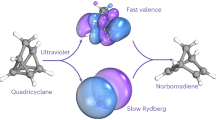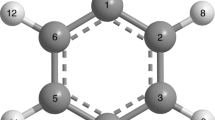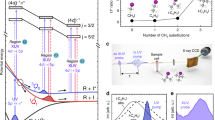Abstract
Photoinduced isomerization reactions lie at the heart of many chemical processes in nature. The mechanisms of such reactions are determined by a delicate interplay of coupled electronic and nuclear dynamics occurring on the femtosecond scale, followed by the slower redistribution of energy into different vibrational degrees of freedom. Here we apply time-resolved photoelectron spectroscopy with a seeded extreme ultraviolet free-electron laser to trace the ultrafast ring opening of gas-phase thiophenone molecules following ultraviolet photoexcitation. When combined with ab initio electronic structure and molecular dynamics calculations of the excited- and ground-state molecules, the results provide insights into both the electronic and nuclear dynamics of this fundamental class of reactions. The initial ring opening and non-adiabatic coupling to the electronic ground state are shown to be driven by ballistic S–C bond extension and to be complete within 350 fs. Theory and experiment also enable visualization of the rich ground-state dynamics that involve the formation of, and interconversion between, ring-opened isomers and the cyclic structure, as well as fragmentation over much longer timescales.

This is a preview of subscription content, access via your institution
Access options
Access Nature and 54 other Nature Portfolio journals
Get Nature+, our best-value online-access subscription
$29.99 / 30 days
cancel any time
Subscribe to this journal
Receive 12 print issues and online access
$259.00 per year
only $21.58 per issue
Buy this article
- Purchase on Springer Link
- Instant access to full article PDF
Prices may be subject to local taxes which are calculated during checkout




Similar content being viewed by others
Data availability
Data generated or analysed during this study are included in this Article (and its Supplementary Information). Source data are provided with this paper.
Code availability
The analysis codes used to generate the data presented in this study are available from the corresponding authors upon reasonable request. Source data are provided with this paper.
References
Minitti, M. P. et al. Imaging molecular motion: Femtosecond X-Ray scattering of the ring opening in 1,3-cyclohexadiene. Phys. Rev. Lett. 114, 255501 (2015).
Pullen, M. G. et al. Imaging an aligned polyatomic molecule with laser-induced electron diffraction. Nat. Commun. 6, 7262 (2015).
Wolter, B. et al. Ultrafast electron diffraction imaging of bond breaking in di-ionized acetylene. Science 354, 308–312 (2016).
Attar, A. R. et al. Femtosecond X-ray spectroscopy of an electrocyclic ring-opening reaction. Science 356, 54–59 (2017).
Schuurman, M. S. & Stolow, A. Dynamics at conical intersections. Annu. Rev. Phys. Chem. 69, 427–450 (2018).
Wolf, T. J. A. et al. The photochemical ring-opening of 1,3-cyclohexadiene imaged by ultrafast electron diffraction. Nat. Chem. 11, 504–509 (2019).
Ruddock, J. M. et al. A deep UV trigger for ground-state ring-opening dynamics of 1,3-cyclohexadiene. Sci. Adv. 5, eaax6625 (2019).
Stankus, B. et al. Ultrafast X-ray scattering reveals vibrational coherence following Rydberg excitation. Nat. Chem. 11, 716–721 (2019).
Browne, W. R. & Feringa, B. L. Light switching of molecules on surfaces. Annu. Rev. Phys. Chem. 60, 407–428 (2009).
Kumpulainen, T., Lang, B., Rosspeintner, A. & Vauthey, E. Ultrafast elementary photochemical processes of organic molecules in liquid solution. Chem. Rev. 117, 10826–10939 (2017).
Qi, J. et al. Light-driven transformable optical agent with adaptive functions for boosting cancer surgery outcomes. Nat. Commun. 9, 1848 (2018).
Deb, S. & Weber, P. M. The ultrafast pathway of photon-induced electrocyclic ring-opening reactions: The case of 1,3-cyclohexadiene. Annu. Rev. Phys. Chem. 62, 19–39 (2011).
Arruda, B. C. & Sension, R. J. Ultrafast polyene dynamics: the ring opening of 1,3-cyclohexadiene derivatives. Phys. Chem. Chem. Phys. 16, 4439–4455 (2014).
Petrović, V. S. et al. Transient X-ray fragmentation: Probing a prototypical photoinduced ring opening. Phys. Rev. Lett. 108, 253006 (2012).
Rudakov, F. & Weber, P. M. Ground state recovery and molecular structure upon ultrafast transition through conical intersections in cyclic dienes. Chem. Phys. Lett. 470, 187–190 (2009).
Adachi, S., Sato, M. & Suzuki, T. Direct observation of ground-state product formation in a 1,3-cyclohexadiene ring-opening reaction. J. Phys. Chem. Lett. 6, 343–346 (2015).
Breda, S., Reva, I. & Fausto, R. UV-induced unimolecular photochemistry of 2(5H)-furanone and 2(5H)-thiophenone isolated in low temperature inert matrices. Vib. Spectrosc. 50, 57–67 (2009).
Murdock, D. et al. Transient UV pump–IR probe investigation of heterocyclic ring-opening dynamics in the solution phase: the role played by nσ* states in the photoinduced reactions of thiophenone and furanone. Phys. Chem. Chem. Phys. 16, 21271–21279 (2014).
Allaria, E. et al. Highly coherent and stable pulses from the FERMI seeded free-electron laser in the extreme ultraviolet. Nat. Photonics 6, 699–704 (2012).
Stolow, A., Bragg, A. E. & Neumark, D. M. Femtosecond time-resolved photoelectron spectroscopy. Chem. Rev. 104, 1719–1757 (2004).
Suzuki, T. Time-resolved photoelectron spectroscopy of non-adiabatic electronic dynamics in gas and liquid phases. Int. Rev. Phys. Chem 31, 265–318 (2012).
Iikubo, R., Sekikawa, T., Harabuchi, Y. & Taketsugu, T. Structural dynamics of photochemical reactions probed by time-resolved photoelectron spectroscopy using high harmonic pulses. Faraday Discuss. 194, 147–160 (2016).
Nishitani, J., West, C. W., Higashimura, C. & Suzuki, T. Time-resolved photoelectron spectroscopy of polyatomic molecules using 42-nm vacuum ultraviolet laser based on high harmonics generation. Chem. Phys. Lett. 684, 397–401 (2017).
Smith, A. D. et al. Mapping the complete reaction path of a complex photochemical reaction. Phys. Rev. Lett. 120, 183003 (2018).
von Conta, A. et al. Conical-intersection dynamics and ground-state chemistry probed by extreme-ultraviolet time-resolved photoelectron spectroscopy. Nat. Commun. 9, 3162 (2018).
Squibb, R. J. et al. Acetylacetone photodynamics at a seeded free-electron laser. Nat. Commun. 9, 63 (2018).
Gorobtsov, O. Y. et al. Seeded X-ray free-electron laser generating radiation with laser statistical properties. Nat. Commun. 9, 4498 (2018).
Xie, B.-B. & Fang, W.-H. Combined quantum trajectory mean‐field and molecular mechanical (QTMF/MM) nonadiabatic dynamics simulations on the photoinduced ring‐opening reaction of 2(5H)‐thiophenone. ChemPhotoChem 3, 897–906 (2019).
Chin, W. S. et al. He I and He II photoelectron spectra of thiophenones. J. Electron Spectrosc. Relat. Phenomena 88-91, 97–101 (1998).
Tao, H. et al. Ultrafast internal conversion in ethylene. I. The excited state lifetime. J. Chem. Phys. 134, 244306 (2011).
Mignolet, B., Curchod, B. F. E. & Martínez, T. J. Rich athermal ground-state chemistry triggered by dynamics through a conical intersection. Angew. Chem. Int. Ed. Engl. 55, 14993–14996 (2016).
Bock, H., Mohmand, S., Hirabayashi, T. & Semkow, A. Gas-phase reactions. 29. Thioacrolein. J. Am. Chem. Soc. 104, 312–313 (1982).
Yang, C.-S., Bhattacharyya, S., Liu, L., Fang, W.-H. & Liu, K. Real-time tracking of the entangled pathways in the multichannel photodissociation of acetaldehyde. Chem. Sci. https://doi.org/10.1039/d0sc00063a (2020).
Svetina, C. et al. The low density matter (LDM) beamline at FERMI: optical layout and first commissioning. J. Synchrotron Radiat. 22, 538–543 (2015).
Lyamayev, V. et al. A modular end-station for atomic, molecular, and cluster science at the low density matter beamline of FERMI@Elettra. J. Phys. B 46, 164007 (2013).
Finetti, P. et al. Pulse duration of seeded free-electron lasers. Phys. Rev. X 7, 021043 (2017).
Eland, J. H. D. et al. Complete two-electron spectra in double photoionization: the rare gases Ar, Kr, and Xe. Phys. Rev. Lett. 90, 053003 (2003).
Zangrando, M. et al. Recent results of PADReS, the photon analysis delivery and reduction system, from the FERMI FEL commissioning and user operations. J. Synchrotron Radiat. 22, 565–570 (2015).
Werner, H.-J. in Advances in Chemical Physics: Ab Initio Methods in Quantum Chemistry Part 2 Vol. 69 (ed. Lawley, K. P.) Ch. 1 (Wiley, 1987).
Roos, B. O. in Advances in Chemical Physics: Ab Initio Methods in Quantum Chemistry Part 2 Vol. 69 (ed. Lawley, K. P.) Ch. 7 (Wiley, 1987).
Hehre, W. J., Ditchfield, R. & Pople, J. A. Self-consistent molecular orbital methods. XII. Further extensions of Gaussian-type basis sets for use in molecular-orbital studies of organic-molecules. J. Chem. Phys. 56, 2257–2261 (1972).
Hariharan, P. C. & Pople, J. A. Influence of polarization functions on molecular-orbital hydrogenation energies. Theor. Chem. Acc. 28, 213–222 (1973).
Werner, H.-J. et al. MOLPRO, v.2012.1 (Molpro, 2012); https://www.molpro.net
Hudock, H. R. et al. Ab initio molecular dynamics and time-resolved photoelectron spectroscopy of electronically excited uracil and thymine. J. Phys. Chem. A 111, 8500–8508 (2007).
Shiozaki, T., Győrffyet, W., Celani, C. & Werner, H.-J. Communication: Extended multi-state complete active space second-order perturbation theory: Energy and nuclear gradients. J. Chem. Phys. 135, 081106 (2011).
Granovsky, A. Extended multi-configuration quasi-degenerate perturbation theory: The new approach to multi-state multi-reference perturbation theory. J. Chem. Phys. 134, 214113 (2011).
BAGEL Brilliantly Advanced General Electronic-Structure Library v.1.2.2 (Shiozaki Group, 2018); http://www.nubakery.org
Ghigo, G., Roos, B. O. & Malmqvist, P. A. A modified definition of the zeroth-order Hamiltonian in multiconfigurational perturbation theory (CASPT2). Chem. Phys. Lett. 396, 142–149 (2004).
Tully, J. C. Molecular dynamics with electronic transitions. J. Chem. Phys. 93, 1061–1071 (1990).
Adamo, C. & Barone, V. Toward reliable density functional methods without adjustable parameters: The PBE0 model. J. Chem. Phys. 110, 6158–6169 (1999).
Ufimtsev, I. S. & Martínez, T. J. Quantum chemistry on graphical processing units. 3. analytical energy gradients, geometry optimization, and first principles molecular dynamics. J. Chem. Theory Comput. 5, 2619–2628 (2009).
Acknowledgements
S.P., J.T. and D.R. were supported by the National Science Foundation (NSF) grant PHYS-1753324. S.P. was also partially supported by the Chemical Sciences, Geosciences, and Biosciences Division, Office of Basic Energy Sciences, Office of Science, US Department of Energy (DOE) under grant no. DE-FG02-86ER13491. Travel to FERMI for S.P., D.M.P.H., R.M., J.T. and D.R. was supported by LaserLab Europe. This work made use of the facilities of the Hamilton HPC Service of Durham University. M.N.R.A., C.S.H. and R.A.I. acknowledge the Engineering and Physical Sciences Research Council (EPSRC) for funding (EP/L005913/1), while L.M.I. acknowledges the EPSRC for a doctoral studentship (EP/R513039/1). C.S.H. also acknowledges funding from the Australian Research Council (ARC, DE200100549). M.N.R.A. thanks W.-H. Fang (Beijing Normal University) for permission to share data28 prior to its publication. B.F.E.C. acknowledges funding from the European Union Horizon 2020 research and innovation programme under grant agreement no. 803718 (SINDAM). D.M.P.H. was supported by the Science and Technology Facilities Council, UK. R.F. and R.J.S. acknowledge financial support from the Swedish Research Council, the Knut and Alice Wallenberg Foundation, Sweden, and the Faculty of Natural Science of the University of Gothenburg. We thank the technical and scientific teams at FERMI for their hospitality and their support during the beamtime. We also acknowledge helpful discussions with A. Rudenko during the preparation of the beamtime proposal and during the data interpretation and with S. Bhattacharyya during the data analysis and interpretation.
Author information
Authors and Affiliations
Contributions
R.B., R.A.I., C.S.H., M.N.R.A. and D.R. conceived the experiment, the plans for which benefitted from further input from R. Forbes, D.M.P.H. and A.R. The experiment was conducted by S.P., R.A.I., R.B., C.C., A.D., B.E., R. Feifel, M.D.F., L.G., C.S.H., D.M.P.H., R.M., O.P., K.C.P., A.R., R.J.S., J.T., M.N.R.A. and D.R. at the FERMI free-electron laser facility. R. Feifel and R.J.S. provided and operated the magnetic bottle spectrometer. C.C., M.D.F. and O.P. prepared and operated the beamline and the low-density matter (LDM) instrument. A.D. and L.G. prepared and operated the optical laser and the free-electron laser, respectively. L.M.I. and B.F.E.C. performed the ab initio simulations, with contributions from R.A.I. Experimental data were analysed by S.P. and J.T. with contributions from C.C., R. Forbes, C.S.H., R.A.I., R.M. and A.R. Finally, S.P., L.M.I., R.B., R. Forbes, M.N.R.A., B.F.E.C. and D.R. interpreted the results and wrote the manuscript with input from all the authors.
Corresponding authors
Ethics declarations
Competing interests
The authors declare no competing interests.
Additional information
Publisher’s note Springer Nature remains neutral with regard to jurisdictional claims in published maps and institutional affiliations.
Supplementary information
Supplementary Information
Supplementary discussion, Figs. 1–17 and Tables 1–3.
Source data
Source Data Fig. 2
Source data for Fig. 2.
Source Data Fig. 3
Source data for Fig. 3.
Source Data Fig. 4
Source data for Fig. 4.
Rights and permissions
About this article
Cite this article
Pathak, S., Ibele, L.M., Boll, R. et al. Tracking the ultraviolet-induced photochemistry of thiophenone during and after ultrafast ring opening. Nat. Chem. 12, 795–800 (2020). https://doi.org/10.1038/s41557-020-0507-3
Received:
Accepted:
Published:
Issue Date:
DOI: https://doi.org/10.1038/s41557-020-0507-3



